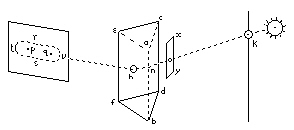Why XMM-Newton?
Newton's Breakthroughs
Newton's first achievement was the development of fluxions, or integral calculus, providing him with the mathematical tools he required for the rest of his work. It led to an acrimonious debate with another scientist, Gottfried Leibnitz, who also claimed credit.
His second breakthrough was the discovery of the law of the composition of light, described in Opticks first published in 1704. He discovered chromatic aberration and the selective refrangibility of colours. His demonstration that light can be split with a prism into its different colours forms the basis of spectroscopy. Although he was not the true inventor of the reflecting telescope, he was the first to make such an instrument and to explain why it was better than a refracting one. Newton was to make many observations with his telescope, sighting for instance, in 1682, the comet later called Halley's Comet.
 |
|
Newton showed that light can be split by a prism in to its different colours. |
But Newton's most profound contribution to science is his formulation of his three Laws of Motion, advanced in his monumental treatise Philosophiae Naturalis Principia Mathematica published in 1687 which lays the foundation for the principle of universal gravitation.
In the third book of Principia he states: "There is a power of gravity pertaining to all bodies, proportional to the several quantities of matter which they contain."
With this law, the doors of physics were thrown open. All objects in the Universe were suddenly equal, and the notion of hierarchy that had dominated all consideration of the Solar System was eliminated. A mystical approach to understanding the workings of the Universe was replaced by a mechanistic one.
Gravity now explained how the planets moved - although this new knowledge brought difficulties since if each object affected every other, the resulting calculations of their motion were extremely complex. Newton was to admit to being unable to calculate other than in a general way the orbits of the planets in the Solar System. But he did manage to obtain much better results than his predecessors.
Newton's fields of study also covered chemistry, or alchemy as it was termed during his day. He compiled an Index chemicus with over 5000 references to other works, sifting through the jibberish in search of the real basis for chemistry. He also invented the sextant - an instrument used for measuring the angular distance between objects.
Any encyclopedia of science will reveal more references to Newton than to any other individual scientist. Before Newton science was a mixture of isolated facts and laws, capable of describing some phenomena and predicting only a few. Applying a rigorous scientific approach, he left it with a unified system of laws that could be applied to a wide range of physical phenomena and which could be used to make exact predictions.
Isaac Newton died in 1727 and was buried in Westminster Abbey, England, the first scientist to be accorded this honour.
